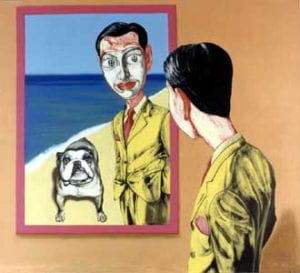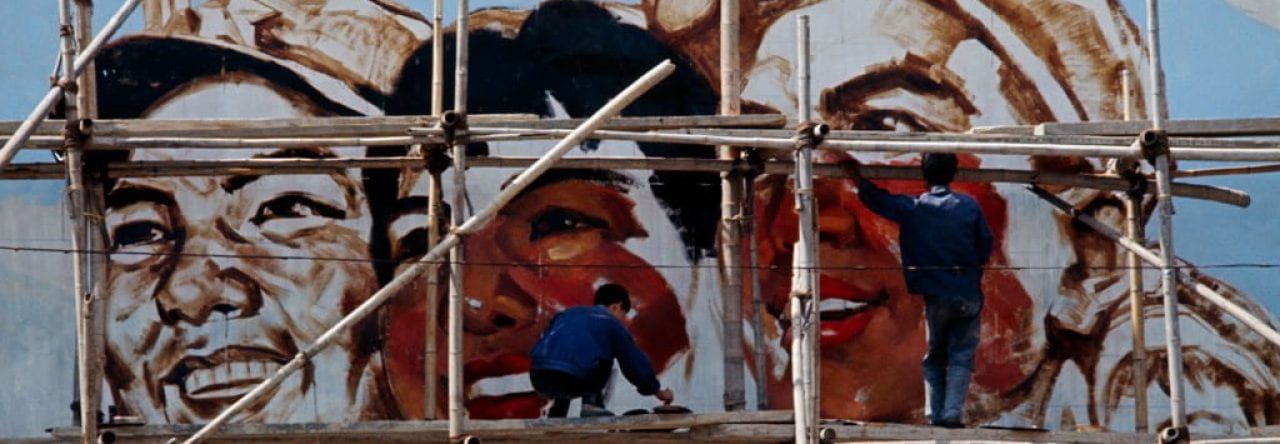 This is Mask Series No.26, an oil on canvas created in 1995 by Zeng Fanzhi. We are shown two happy figures, a man and his dog. The observer is situated behind the man in the work, almost as if we are looking over his shoulder and getting a glimpse into his life. This man is looking into a mirror that shows a realistic reflection of himself and a dog, however the dog is not next to him in real life. His reflection is on a beach elsewhere. The most significant aspect of the painting is the mask on his face in the mirror.
This is Mask Series No.26, an oil on canvas created in 1995 by Zeng Fanzhi. We are shown two happy figures, a man and his dog. The observer is situated behind the man in the work, almost as if we are looking over his shoulder and getting a glimpse into his life. This man is looking into a mirror that shows a realistic reflection of himself and a dog, however the dog is not next to him in real life. His reflection is on a beach elsewhere. The most significant aspect of the painting is the mask on his face in the mirror.
The man is dressed in a bright yellow suit, with finely combed hair. He has a white mask covering his mouth, eyes, and nose. His eyes are wide, with wide red lips. An interesting thing to note is that the mask fits so well on his face that if the mask and his skin were the same color it would be very difficult to tell the apart. This suggests that he has been wearing it for so long or that it has become a part of him.
What does the mask symbolize, though? In the 1990’s, China was undergoing social and economic changes that were sparked by public unrest and globalization. The Tiananmen protest in 1989 implored for greater freedom, and globalization policies led to increased business with other countries [1]. What developed was a greater divide between the population as some benefitted more than others and led privileged lives. Essentially, a greater sense of individualism was taking root even though Chinese society placed an emphasis on collectivism. In fact, the economic reforms introduced profit incentives that increased the share of private and joint ventures by 8 percent [2]. People were focused on their own success, but were pressured into wearing a “mask” and saying its for the country’s benefit. This tension is what Zeng Fanzhi is highlighting.
Knowing this, the themes of wealth and the eagerness to show it are clearly displayed by the nice suit the man is wearing the beach he is on. This man is a component of the urban elite and his phony intentions are painted through satire; I mean look at that goofy mask! Interestingly, the mirror adds another implicit dynamic symbolizing the superficiality of the situation. Everyone is masquerading their patriotism but when they look in the mirror, you can see the truth. In the dog’s case, his truth doesn’t need a mask because he isn’t subjected to the pressures a human is.
Work Cited
1.Linda Chao & Ramon H. Myers (1998) China’s consumer revolution: The 1990s and beyond, Journal of Contemporary China, 7:18, 351-368, DOI: 10.1080/10670569808724319
2.Hu, Zuliu, and Mohsin S Khan. “Economic Issues 8 — Why Is China Growing so Fast?” International Monetary Fund, June 1997, https://www.imf.org/external/
Image:
上海香格纳文化艺术品有限公司 . “Mask Series 1995 No.26.” ShanghArt, https://www.shanghartgallery.com/galleryarchive/work.htm?workId=1309. Accessed 20 Apr. 2023.


Sadie Hill
What a cool and striking painting and a great analysis! This painting immediately caught my eye, I think it was the colors at first, but then I started picking it apart. It was super interesting to learn about what you had to say in regards to the mask, because that was my first question. I think, springing off from what you had to say about the mask relating to assimilation and anti-individualism, that is is very interesting that the mask is black and white! It looks like almost like a newspaper or a scanned image, like the person themselves is “massed produced.” I agree with what you said about the dog too, that it is not subjected to the human societal pressures. I also wonder what it is even doing there!! Also, where is it outside of the mirror? Is it floating behind the man? The more I look at this painting, the stranger it gets. However, I think you did a great job picking it apart.
Julian Kalmanoff
I found this painting and the analysis to be very interesting. This kind of art is somewhat similar to the kinds of art that I am looking at so when I heard how you analyzed the painting it gave me a better idea of how to really look at every little detail to get a full picture of what it all means.